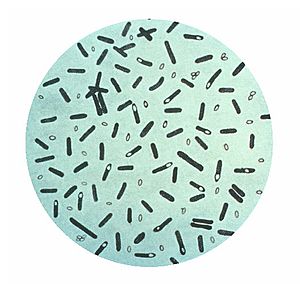Clostridia facts for kids
Quick facts for kids Clostridia |
|
|---|---|
 |
|
| Clostridium botulinum | |
| Scientific classification |
|
| Domain: | Bacteria |
| Phylum: | Firmicutes |
| Class: | Clostridia Rainey 2010 |
| Orders | |
|
|
The Clostridia are a group of tiny living things called bacteria. They are part of a larger family known as Firmicutes. You might know some of them, like Clostridium, which is a common type in this group.
Contents
What are Clostridia?
These bacteria are special because they are obligate anaerobes. This means they cannot live or grow when there is oxygen around. In fact, oxygen is like a poison to them! They don't use oxygen to "breathe" like we do.
Many Clostridia, especially those in the Clostridium group, are Gram-positive. This is a way scientists classify bacteria based on their cell walls. These bacteria can also form tough, protective covers called spores. Spores help them survive in harsh conditions.
Where Clostridia Live
Most types of Clostridium are saprophytic organisms. This means they get their food from dead or decaying plants and animals. You can find them in many places, especially in the soil.
Clostridia and Health
While many Clostridia are harmless, some types can cause problems for humans. These are called pathogens. They can produce very strong toxins (poisons) that are among the most dangerous known.
For example, C. tetani makes a toxin that causes tetanus. This is a serious illness that affects your muscles. Another example is C. botulinum, which produces the botulinum toxin. This toxin can cause botulism, a rare but severe illness.
Important Clostridia Species
Here are some well-known types of Clostridia:
- Clostridium perfringens: This can cause gangrene (a serious tissue infection) and food poisoning.
- Clostridium difficile: This bacterium can lead to a severe gut infection called pseudomembranous colitis.
- Clostridium tetani: This is the bacterium that causes tetanus.
- Clostridium botulinum: This one causes botulism.
- Clostridium acetobutylicum
- Clostridium haemolyticum
- Clostridium novyi
- Clostridium oedematiens
Did you know that Heliobacteria are also part of the Clostridia group?
See also
 In Spanish: Clostridia para niños
In Spanish: Clostridia para niños

